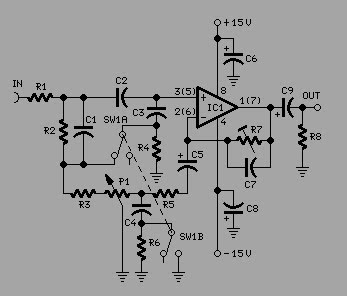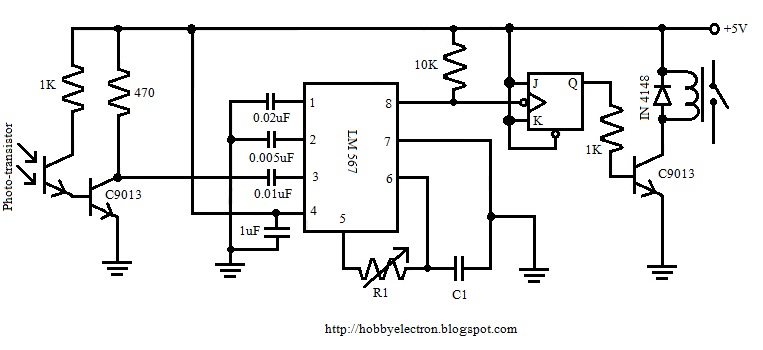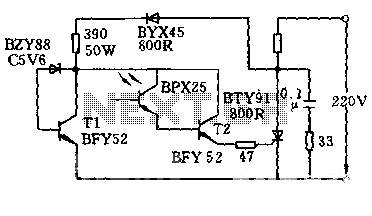
Night circuit diagram showing target

This circuit is designed for nighttime illumination and corridor lighting. During daylight, sufficient light causes BG3 to conduct, preventing the SCR from oscillating. As a result, the circuit remains inactive, and the light does not turn on. At night, BG3 turns off, allowing the SCR to trigger and activate the oscillation circuit, which is composed of an integrated circuit (IC) among other components. The IC generates a continuous ultra-low frequency square wave output, with a frequency defined by the formula f = 1/T = 1.44/(W + Ra + 2Rb)C. The IC connects to an LED that produces a twinkling effect, making it visually striking. The values of Ra, Rb, and C1 can be adjusted to modify the flash frequency.
This circuit operates based on the principles of light detection and SCR (Silicon Controlled Rectifier) triggering. The BG3 component functions as a light sensor, effectively distinguishing between day and night conditions. During daylight hours, the ambient light level is sufficient to keep the BG3 in a conductive state, which prevents the SCR from entering its conductive phase. This ensures that the connected lighting remains off during the day, conserving energy and preventing unnecessary illumination.
Upon the onset of darkness, the BG3 sensor ceases to conduct, which allows the SCR to be triggered. The SCR is a critical component in this circuit, as it enables the flow of current through the oscillation circuit. The oscillation circuit is primarily driven by an integrated circuit (IC) that generates a square wave output. The frequency of this output is determined by the resistors (Ra, Rb) and the capacitor (C) in the circuit. The relationship between these elements is given by the formula f = 1/T = 1.44/(W + Ra + 2Rb)C, where W represents any additional components that may influence the timing characteristics.
The output of the IC is connected to an LED, which produces a twinkling light effect. This effect is visually appealing and serves to enhance the aesthetic of the corridor or area being illuminated. The flash frequency can be adjusted by varying the values of the resistors and capacitor, allowing for customization based on specific requirements or preferences.
Overall, this circuit effectively combines light sensing, SCR triggering, and oscillation generation to provide an energy-efficient and visually engaging lighting solution for nighttime applications. The use of adjustable components allows for flexibility in design, making it suitable for various environments and user needs. As shown, this circuit is suitable for shooting at night and turned on the lights corridor. During the day due to sufficient light, BG3 conduction, SCR blocking oscillation cir cuit by an IC or the like can not work without voltage, so light is not on. Night, since BG3 off, SCR triggered by conduction, so by the oscillation start oscillation circuit composed of IC, etc., IC 3 ultra-low frequency square wave output continuously, the frequency f 1/T 1.44/(W + Ra + 2Rb ) C, the IC can be seen between 3 and connected to the LED twinkling light, very eye-catching. Ra Rb as C1 adjust the size of flash frequency can be changed.
This circuit operates based on the principles of light detection and SCR (Silicon Controlled Rectifier) triggering. The BG3 component functions as a light sensor, effectively distinguishing between day and night conditions. During daylight hours, the ambient light level is sufficient to keep the BG3 in a conductive state, which prevents the SCR from entering its conductive phase. This ensures that the connected lighting remains off during the day, conserving energy and preventing unnecessary illumination.
Upon the onset of darkness, the BG3 sensor ceases to conduct, which allows the SCR to be triggered. The SCR is a critical component in this circuit, as it enables the flow of current through the oscillation circuit. The oscillation circuit is primarily driven by an integrated circuit (IC) that generates a square wave output. The frequency of this output is determined by the resistors (Ra, Rb) and the capacitor (C) in the circuit. The relationship between these elements is given by the formula f = 1/T = 1.44/(W + Ra + 2Rb)C, where W represents any additional components that may influence the timing characteristics.
The output of the IC is connected to an LED, which produces a twinkling light effect. This effect is visually appealing and serves to enhance the aesthetic of the corridor or area being illuminated. The flash frequency can be adjusted by varying the values of the resistors and capacitor, allowing for customization based on specific requirements or preferences.
Overall, this circuit effectively combines light sensing, SCR triggering, and oscillation generation to provide an energy-efficient and visually engaging lighting solution for nighttime applications. The use of adjustable components allows for flexibility in design, making it suitable for various environments and user needs. As shown, this circuit is suitable for shooting at night and turned on the lights corridor. During the day due to sufficient light, BG3 conduction, SCR blocking oscillation cir cuit by an IC or the like can not work without voltage, so light is not on. Night, since BG3 off, SCR triggered by conduction, so by the oscillation start oscillation circuit composed of IC, etc., IC 3 ultra-low frequency square wave output continuously, the frequency f 1/T 1.44/(W + Ra + 2Rb ) C, the IC can be seen between 3 and connected to the LED twinkling light, very eye-catching. Ra Rb as C1 adjust the size of flash frequency can be changed.





